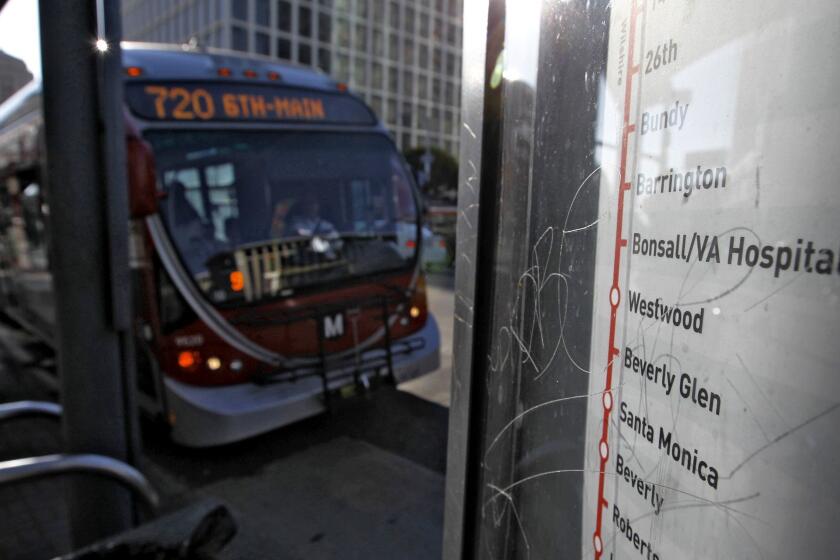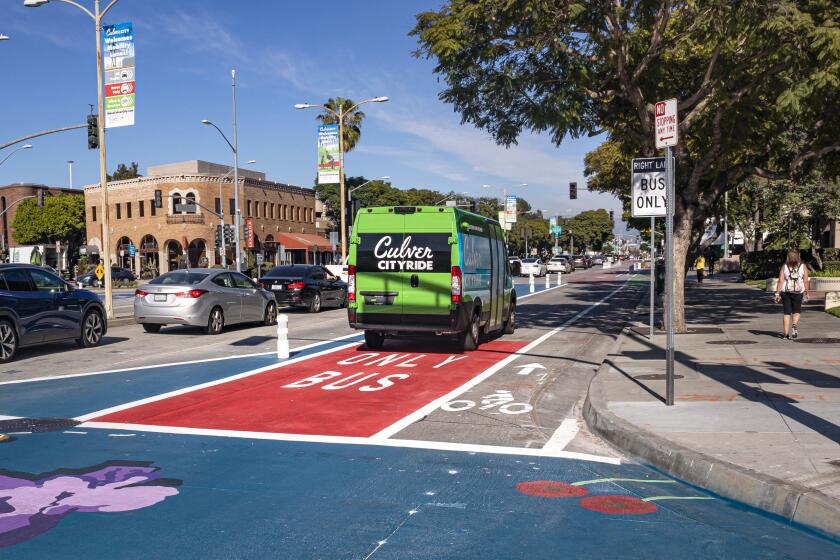Culver City, don’t roll back your ambitious safe street redesign

- Share via
In 2021, Culver City rolled out one of the most ambitious street redesigns in the region. The idea was simple but radical in an area that has long catered to motorists and become mired in car traffic. Why not carve out space on some streets to make it easier and safer to walk, bike and take transit so residents, workers and visitors don’t have to drive?
In the heart of its downtown, near restaurants, apartments, studios and government offices and the Expo Line, Culver City removed a car lane in each direction and replaced them with protected bike and bus-only lanes.
The project, called Move Culver City, was a 1.3 mile pilot project, quickly built for relatively low cost with paint, removable planters and plastic bollards. The goal was to test the theory that if people are given quality transportation choices, they will use them.
And that’s what happened.
It’s time — again — to test whether Los Angeles’ political leaders have the mettle to build a transit-friendly, environmentally sustainable city.
A review of the project after a year found an 18% increase in people walking and 32% more people biking through the area. At the intersection of Culver Boulevard and Main Street, the number of bikes counted. nearly doubled. Bus travel became faster and ridership increased more on the corridor compared to citywide. People said they were biking, walking and taking transit more often in the area, according to the review. They felt safer, more comfortable and noticed fewer speeding cars.
As for traffic? It moved faster in the morning hours, and in the evening it took drivers about two minutes longer to pass through the area. Two minutes. That’s a minor inconvenience. It certainly seems like a fair trade off to make the corridor safer and more convenient for alternative modes of transportation — which was the purpose of the project.
But instead of making the changes permanent, a new, more conservative majority on the City Council may roll back the street redesign at its meeting Monday night in response to motorists complaints that the project has made traffic worse. That would be a shame.
If state leaders are serious about making California affordable, they should block local laws that require parking that may be unnecessary and costly.
Over the last several years, Culver City has been a model of forward-thinking urban design. Previous leaders recognized the city had transformed into a hub for tech giants and streaming studios, creating thousands of new jobs. But the pace of residential development hadn’t kept up. That drove up housing costs and worsened traffic and pollution as commuters drove into the area for work.
The city couldn’t widen any more streets (and that doesn’t solve traffic anyway) or build more single-family subdivisions. City officials decided to create a denser, transit-friendly, walkable, bikeable center that would allow more people to live in the city and give commuters more options to get to their jobs. The vast majority of Culver City is still car-centric, but this small section shows how urban Los Angeles can build more affordable, equitable and environmentally responsible communities.
Yet even the modest encroachment of Move Culver City may be too much for opponents of the project, who seem particularly offended by the bus lane. There is a proposal to add back a car lane and make buses and bicyclists share a lane, which would dissuade all but the most confident cyclists and slow the buses, thus making alternative modes of transportation a lot less appealing. And for what? So some drivers can get to their destination two minutes faster.
The Culver City Council will vote on its recently protected bus and bike lanes. At stake is how Angelenos see the future of transit in our region.
Like most communities across California, Culver City has plenty of plans detailing its commitment to bike lanes, public transit and sustainable city design as strategies to reduce greenhouse gases from vehicle pollution to help fight climate change. But those plans are meaningless if elected leaders don’t have the political backbone to see them through.
What’s the big deal, you might ask, if one small city rolls back one small bus and bike lane project? It’s significant because road redesigns are always going to controversial and challenging in an urban landscape designed for, but now overwhelmed by, cars. In Los Angeles, agencies have backed off plans to add protected bike lanes and bus lanes to placate motorists. In 2017, after a teenager was killed crossing Vista del Mar near Dockweiler Beach, the city removed traffic lanes and redesigned the street to make it safer. But commuters browbeat city leaders until they reversed the project. Since then two more people have been killed by vehicles while crossing the street.
We will never have safe streets and quality transit if the region’s political leaders scrap or scale back projects when there is opposition to change. Move Culver City is a success and a model for a cleaner, greener, more livable region. It would nice if Culver City leaders could recognize that.
More to Read
Insights
L.A. Times Insights delivers AI-generated analysis on Voices content to offer all points of view. Insights does not appear on any news articles.
Viewpoint
Perspectives
The following AI-generated content is powered by Perplexity. The Los Angeles Times editorial staff does not create or edit the content.
Ideas expressed in the piece
- The Move Culver City project successfully increased sustainable transportation use, with a 32% rise in cycling, 18% more pedestrians, and faster bus travel times after its implementation[1][2]. Data showed improved safety perceptions and reduced speeding, supporting its goal of prioritizing people over cars[1][6].
- Urban design advocates highlight its role as a model for equitable, climate-friendly infrastructure, aligning with regional goals to reduce emissions and car dependency[1][5]. The project’s “quick-build” approach—using temporary materials like paint and bollards—demonstrated how cities can test transformative changes affordably[2][6].
- Supporters argue that minor traffic delays (averaging two minutes) are a reasonable trade-off for safer streets and expanded transit options[1]. The redesign also connected key destinations like Metro’s Expo Line station, enhancing accessibility for residents and workers[6].
Different views on the topic
- Critics argue the redesign worsened traffic congestion during peak hours, prompting the City Council to scale back protected bike lanes and restore a car lane in late 2024[3][4]. Opponents claim prioritizing buses and bikes inconveniences drivers in a region still dominated by car travel[4].
- Some residents and officials criticize shared bus/bike lanes as less safe for cyclists, potentially discouraging ridership despite no reported collisions during the pilot[4][7]. Concerns about temporary materials like plastic bollards also fueled perceptions of reduced aesthetic quality and durability[7].
- Political pushback reflects broader tensions in Los Angeles over street redesigns. Critics argue such projects face reversals due to vocal driver complaints, undermining long-term climate and safety goals[1][3]. The council’s decision highlights challenges in balancing progressive urban planning with immediate constituent demands[2][4].
A cure for the common opinion
Get thought-provoking perspectives with our weekly newsletter.
You may occasionally receive promotional content from the Los Angeles Times.











